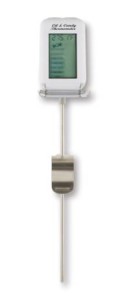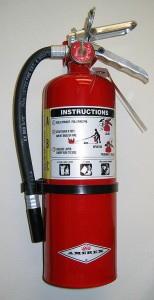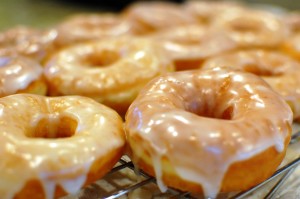This is a column I’m written to set up for future columns. I wanted to do recipes for french fries, corn dogs, fried fish, homemade chips, and lots of other gaming staple snack foods, but all these things have one thing in common – Deep Frying. And there’s a lot going on with deep frying, so I thought the best way to do it would be to go over the basics so I can link back to this later.
So, what is frying? It’s actually a dry cooking method, believe it or not, that allows for an amazing transfer of heat. That’s why fried foods are always golden brown and crisp. It’s also not the healthiest cooking method, but honestly, it’s not nearly as bad as people think if you do it properly. Because of several factors I’ll get into later, very little oil actually gets into the food.
There’s a lot involved in deep frying, but it’s also a lot of simple things. So let’s go over the important points.
The Frying Vessel
I’ve got friends with those residential countertop fry things. I’ve never seen one that can get the oil hot enough consistently enough to brown the food properly, and it ends up greasy and gross every single time. Commercial fryers are expensive and won’t even work on most residential electrical wiring. So we’re out of luck for getting good fried foods at home, right? Wrong! We’re going old school with one of my favorite cooking vessels, the cast iron dutch oven.
 The 5 Quart Lodge Cast Iron Dutch Oven…I would marry you if I wouldn’t cheat with my Lodge 12″ cast iron skillet…
The 5 Quart Lodge Cast Iron Dutch Oven…I would marry you if I wouldn’t cheat with my Lodge 12″ cast iron skillet…
Get one that’s either five to seven quarts, and it’s perfect for frying. It’s also perfect for stews and braising and soups and, well, lots of other things. Cast iron is awesome. Because of the density of cast iron, it holds onto heat well and doses it out evenly. Plus you can get it hot as hell if you need to before you damage it (way beyond what most home stoves can dish out). Why is density important in frying?
Okay, there’s thermodynamics involved here, so science warning. Most food should be kept cold until it’s introduced to heat. In a perfect world, food would be raised to room temperature before it’s cooked to maximize thermal changes. It’s easier to get something hot when it’s warm to start with because less heat energy that needs to be transferred. The problem is the dreaded Danger Zone. Fruits, vegetables, legumes, dough, and usually beef and processed sausages are okay to let come to room temp. But your favorite fried treats – fish, shrimp, shellfish, chicken, and pork – you just can’t do that without the potential of serious illness.
Why would you care? Thermodynamics. “Cold” is a very odd thing. It’s not actually a thing in and of itself, it’s a lack of a thing. Specifically, heat energy. If something is “cold”, it’s lacking in heat energy. Cooking is all about controlled dosing of heat energy, which is why heat management is very important. When you put cold food into a hot pan or into oil, it sucks up the heat energy into itself. This lowers the temperature of whatever you’re cooking in.
This is where the density of cast iron is important. When you drop food in, the oil cools down. You have to keep that heat up or bad things will happen (see below). Commercial fryers do this with a massive volume of oil and industrial level heating elements. Home countertop fryers hold far less oil and their heating elements just can’t keep up without raising the oil above its smoke point (see below). In a home environment, the only way to do it is cast iron.
Because of the mass of cast iron (seriously, my dutch oven weighs like ten fucking pounts), it holds onto more heat energy than most other cooking vessels. So there’s more heat stored in the dutch oven to be transferred to the oil. This also means you can trust it a little more than something like aluminum and don’t have to micromanage your heat levels as much.
 This will be your best friend.
This will be your best friend.
The other critical component for a home frying rig is the thermometer. You want something that is responsive and easy to read, and for me that means a digital thermometer. They’re a little pricy compared to other thermometers (like $20-30), but a clear digital display and sensitivity to update in seconds is critical. You need to know when your oil comes to temperature or when it starts to dip so you can adjust the heat. The one I linked above is the one I use because it’s fast and accurate. I don’t like the bulb-based ones with the rising liquid because they can be hard to see or judge accurately, and I fucking hate the dial-based ones because they are based on coil springs that are horribly inaccurate, slow to respond, and get worse the longer you have them. If you have a digital probe thermometer you use for roasts, that will work too but use one of those plastic binder clips to hold them in place.
Oh, there’s one more very critical piece of equipment you need in your kitchen when frying.
Heat Management
Like most forms of cooking, frying is all about applying the correct amount of heat to food. This is more critical in frying because the oil does different things at different temperatures. Each type of oil has what’s called a “smoke point“ and, regardless of what charts you see, it’s not a fixed number. When oil reaches a certain temperature, the fat molecules start to break down. The higher the heat, the faster this happens. When these molecules break down, they create nasty-smelling smoke and bitter flavors. They also have more of a tendency to soak into the foods, making them greasy.
The reason most restaurants use peanut oil in their fryers is it has a high smoke point and neutral flavor. It is, however, more expensive and some people have allergies to it (though refined peanut oil should not trigger most peanut allergies as the compounds that most people are allergic to are not present in the type of peanut oil used in frying). Corn, canola, safflower, and vegetable oil can all be used instead (and I’d recommend them in that order) due to their higher smoke points and neutral flavor, but really peanut oil is king here. Whatever oil you use, try to get the refined version as it will not break down as quickly.
Depending on what exactly you’re frying, you’ll almost always want an oil temperature of at least 325 degrees but no more than 375 (give to take a few degrees). Anything under 325 isn’t going to be hot enough to create an effective water barrier to the food and cook too slowly, while hitting 400 or higher will be too close to the smoke point and cause the oil to break down quickly.
How Frying Works
So we’ve got our frying vessel and our oil. Add the oil to the dutch oven but make sure not to fill it more than 4/5 full (otherwise you’ll probably need that fire extinguisher). Your first reaction might be to put it over high heat so that the oil will heat faster, but you’re far better off being patient and using medium heat. This will allow convective currents to form in the oil (hot oil rises, cold oil sinks and gets heated, and so on) and lets the oil heat far more evenly. It can take 15-20 minutes for it to reach temperature, but don’t leave it unsupervised because that can be a hazard.
Besides, most fried foods are battered or dredged, so it gives you a good time to prep that. What’s the difference? Batters are wet and dredges are dry. Yeah, that’s pretty much it. There’s a couple of big tips I can give for this step of frying, but it really depends on what you’re doing exactly. Most wet batters do best when applied at the last minute before frying since they typically have some sort of leavening agent of some sort. Tempura especially is prepared literally seconds before it goes into the oil. Dredges, however, do best when they rest for about 5 minutes or so. This allows the starch (usually flour but sometimes corn starch or potato starch) to unravel and bind to the food. If you’ve ever bitten into something fried and had the entire coating come right off, it didn’t sit long enough.
Also, most batters don’t like to stick to foods on their own, so they’re dredged anyway before they’re batter-dipped. So even if you’re making something battered, you’re going to dredge it in flour or corn starch anyway, so do that and any other prep while the oil’s heating up.
Okay, we’re now at the most important part of deep frying: Not burning the house down.
 If this happens, don’t do what this person did. Use your fire extinguisher or leave and call 911. Don’t post to Twitter!
If this happens, don’t do what this person did. Use your fire extinguisher or leave and call 911. Don’t post to Twitter!
When food is put into oil, it starts to bubble. You’ve seen this a thousand times when food is fried. What’s happening is that water on the surface of the food is instantly evaporated by the heat from the oil, so it rises out of the oil. That water vapor will also contain droplets of oil. And as any D&D player out there knows, Oil + Small Fire = Large Fire!
This is why you should never fill your frying vessel more than about 4/5 full (that’s a gallon of oil for a 5 quart dutch oven, for the math challenged). If the bubbling is too violent, there’s still room before it overflows onto your heating element. It also gives some of the water vapor a chance to cool as it rises and, again, avoid the heating element of your stove. Because if it does catch, the fire will spread to the pot in almost an instant.
While it’s not quite that easy to start a fire, it’s still important to respect the power that hot oil has when it comes in contact with flames. If you’re able to, the first thing you should do is put the lid on the pot. If you can’t get close enough because the fire’s too big, use a Class B fire extinguisher. If you’re not sure if it’s too big, then it is. Baking soda can also be used on smaller fires as well. But trust me, use the fire extinguisher. Cleaning up the mess is far less of a hassle than dealing with insurance companies.
Do not use water. Frankly, you might be better off throwing gasoline on an oil fire than water. (Note: Don’t do that either). Water causes the oil to spread, which causes the fire to cover more area. It also causes the water to evaporate, and the water vapor carries the oil with it as it goes through the air. And of course, this carries the fire to other flammable things in the kitchen. Just don’t do it.
Same goes if you get splashed with oil. Water is not your friend. Dab the oil off your hand with a dry towel, then apply burn treatments. Adding water spreads the oil which spreads the heat which just makes the burn worse.
Did I scare you? Good, now you’ll respect what oil can do. Did I scare you enough not to try? Relax. I’ve never had an oil fire and I cook a lot while drunk (I don’t think I’ve fried shrimp sober in a decade). Just keep in mind what to do if something does happen and take the minor steps I said above to prevent it from happening in the first place and you’re fine.
What makes fried foods so delicious isn’t the fat that gets added. It’s that the cooking itself tends to be very fast, which preserves natural moisture in the food. It also browns and crisps very well, adding complex flavors and textures. Badly fried foods, though, tend to be greasy and pallid. What makes fried food failures all comes down to two things. Either the oil wasn’t at the right temperature or the food overcooked.
Oil and water don’t mix well. So when you put food into hot oil, you get one of three outcomes.
- The oil is too cold, which means cooking times are longer and more oil is absorbed into the food.
- The oil is too hot, which means the oil has broken down more and allows for faster absorption into the food. Also, the surface moisture of the food will evaporate, allowing oil to be absorbed.
- The oil is at the proper temperature. The oil hasn’t broken down, and the food cooks at the proper rate (maintaining the moisture barrier).
You want to make sure the temperature is correct for the food you’re trying to cook. Frying a whole fish is going to take far longer than popcorn shrimp, for example. I actually prefer pan frying for large foods myself, but that’s another column. Things like corn dogs are fine, though, because the food in the center has already been cooked. It just needs to be heated through, not cooked completely.
If your fried foods cook too quickly, the surface will dry out and allow oil to get into the food before the center is done. If this happens, don’t freak out, there’s a trick you can do to salvage it. Sort of. Pull the food out of the oil first, then put it in a 325 degree oven until it’s cooked through. That temperature is low enough that it shouldn’t burn the surface (which is already cooked) but still enough to finish cooking to the center.
When draining foods, I prefer to use an inverted cooling rack on top of paper towels or newspaper. The excess oil on the surface drips onto the rack, which is pulled away by the paper. This means that the food isn’t sitting next to the oil to just re-absorb it again. The direct contact is important.
Fried foods should be served as quickly as you can after cooking. If you need to hold something, put it in a 250 degree oven (warm enough to keep the food hot, but not so hot it’ll burn). They’ll be okay for about 15-20 minutes. As far as reheating, never ever use a microwave if you can at all help it. Microwaves cook by steam, which just separates the food from its coating. Ovens are best, but you could always give it another dip in the oil.
The oil itself? It’s usually good for at least two frying sessions so long as it doesn’t get too hot and it’s stored in an air-tight container. Let it cool on the stove until at room temperature, then pour it through a mesh filter or preferably a cheese cloth and store at room temperature covered tightly. I usually replace my oil by half every time I fry. So I use a gallon of oil, then filter and save half of it. I’ll add two quarts of fresh oil to the two quarts I saved and use that once before replacing half of it. After four or five replacements, I’ll toss the whole thing and start over.
Peanut oil and most other cooking oils are typically safe to dispose of by pouring out onto the ground as it’s biodegradable, and can also be composted. However, check with your local regulations to be sure and whatever you do, do not dispose of oil in any form of drain or sewage as it can damage many municipal water systems.
And yes, I find no irony in doing a column on fried foods directly following one on my diet. While I don’t fry nearly as often as I did before, I will still do it occasionally. If you fry properly, the food shouldn’t absorb more than a tablespoon of oil, and that’s only if you cook a lot of food (you can measure the oil before and after cooking if you’re curious). I’ve made fish and chips for six people and only lost 1 3/4 teaspoons of oil. Besides, fried foods just taste good. And so long as you do so smartly and in moderation, there’s no reason you can’t enjoy a treat every once in a while.







2 thoughts on “Specialties of the House: How to Fry”
Yay FIRE!!